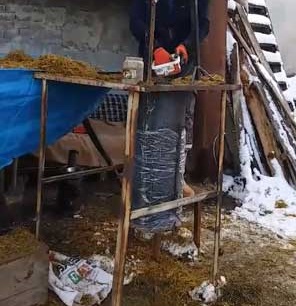YouTube says it's simple:
On the picture: an example of how NOT to do steaming.
The best result at home gives a substrate of sunflower husks.
It has much less mold spores than straw. Therefore, it takes only 3 hours to heat the husk. And straw - at least 6 hours.
The yield of mushrooms on the husk is higher than on straw.
Be sure to add legume grass hay to the straw to increase the yield.
If you watched a video on YouTube and want to make a substrate from sawdust, foliage, paper, make small portions. You will most likely have to throw out those experimental bags.
If there are few of them, you will not be so sorry for your costs and labor.
You can do everything as you read on the Internet, and see for yourself: the first month, maximum two, the blocks will overgrow.
The substrate will then overgrow with dark spots in which bacteria grow. Or trichoderma (green mold) will appear on the substrate.
Therefore, making a substrate "quite easy" will not work.
Which substrate is better - from straw or sunflower husks
At home, it is easier to grow on the husk:
Please do not invent outlandish processing methods with additives!
Do not believe me - do experiments on a small part of the party.
Sign bags, compare yields. If at least one of the above will raise your harvest by at least a couple of percent, I congratulate you.
We need to destroy the competitors of oyster mushroom mycelium: mold spores and bacteria.
It is impossible to heat raw materials during heat treatment above 75C.
At the same time, some of the spores not only survive, but also receive thermal activation - after cooling, they swell and grow faster and more aggressively than the rest of the spores.
From one kilogram of dry sunflower husk, straw, hay, you can get from 2.5 to 3 kilograms of finished steamed mass.
In other words, to make 10 mushroom blocks weighing 10 kg each, you need 25 to 30 kg of dry straw (or its mixture with hay) or husks. Plus three kilograms of grain spawn (if you add 3%)
If you steam raw materials in a two-hundred-liter barrel, you can make 5, maximum 6 mushroom blocks weighing 8.5-9 kg.
5. If you have just started growing oyster mushrooms, you can steam the raw materials by pouring hot water over them.
In doing so, be sure to:
If your raw material is straw, I do not recommend this method at all.
 But this method is possible ONLY if there is a special room for inoculating mycelium (grain spawn) into the substrate - a clean zone or also called a sowing zone. It must be constantly treated to kill mold spores and bacteria.
But this method is possible ONLY if there is a special room for inoculating mycelium (grain spawn) into the substrate - a clean zone or also called a sowing zone. It must be constantly treated to kill mold spores and bacteria.
Unfortunately, even the presence of a clean zone does not guarantee that by pouring raw materials with hot water, you can avoid the appearance of green mold, non-growth spots, and bacterial infection.
If this happens, you will have to switch to hydrothermia*.
You see in the photo - inoculation takes place outdoors
Heat-treated straw is not even covered.
There will definitely be problems in a few months of such work.
Mold and bacteria spores are covered with a thick shell and die at a temperature of at least 121 degrees for 40 minutes.
Therefore, when pouring straw or husks with boiling water (or hot 85-90 degree water), we get rid of only those spores that have swollen or hatched from the shell at the time of heating.
The rest of the spores can germinate simultaneously with the mycelium, and make it a significant competitor.
The longer you grow oyster mushrooms, the more mold and bacteria spores accumulate.
There remain spores that are more resistant to heat treatment.
In the room where the inoculation takes place, spores are most dangerous. Due to high humidity, their number increases.
When germinating, the hyphae of both spores and oyster mushroom mycelium secrete certain substances that inhibit the growth of competitors. It is not always possible for oyster mushroom mycelium to win this fight.
pH in the substrate should be in the range of 7.8-8.2
If there are no problems with overgrowing of the substrate, most likely the pH is in order.
But, when green mold (Trichoderma) appears in the bags, it is necessary to buy a pH meter and measure the alkalinity of the substrate before stuffing.
Read more about pH-substrate here.
* An article about the hydrothermal method
